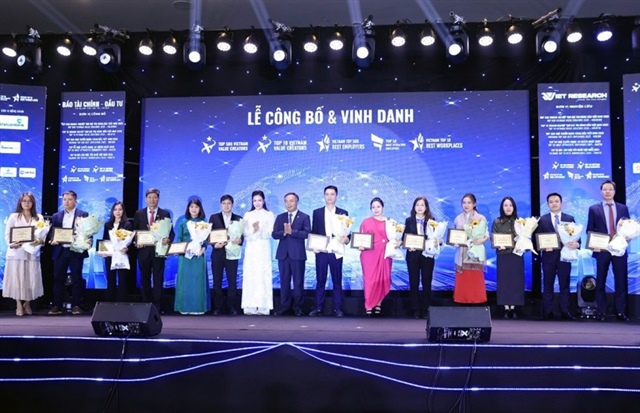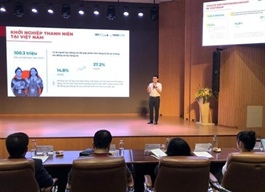VN needs to improve policy quality to escape middle-income trap: conference
VN needs to improve policy quality to escape middle-income trap: conference
Việt Nam needs to improve policy to achieve sustaining economic growth while the middle-income trap is considered to be the biggest challenges during the path to a high-income economy by 2030.

The Vietnamese economy is still heavily dependent on processing industries with weak supporting industries, which are labour – intensive.. — VNA/VNS Photo Trần Việt |
That was position of experts speaking at a conference held by the Australian National University in Canberra on Friday.
At the Việt Nam Policy and Economy Update 2024 conference, Vice President of the Central Institute for Economic Management (CIEM) Đặng Đức Anh said that Việt Nam is facing the risk of falling into the middle-income trap.
Việt Nam’s ambition of becoming a high-income economy by 2045 requires higher productivity growth and investment, he said.
However, the increase in labour productivity is mainly due to increased capital intensity. In addition, labour supply is decreasing, as Việt Nam is nearing the end of the 'era of demographic dividend'.
He also pointed out that the share of manufacturing sector in gross domestic product (GDP) is low compared to others in the same industrial era, such as China and Thailand, while the economy is highly open and heavily dependent on imported raw materials.
The trading partners are more concentrated, leading to more vulnerability to global uncertainties.
“The economy depends heavily on FDI firms that rely on trade and are vulnerable to volatility in the global economy,” he said, citing statistics that the FDI sector contributes more than 70 per cent to the country’s exports in 2023, from just nearly 30 per cent in 1995.
In addition expenditure on research and development (R&D) is modest compared with China, Thailand and Malaysia and the regional median.
Given these risks and challenges, it is critical for Việt Nam to improve the policy implementation for sustaining economic growth, Anh said.
First, the country needs to improve the quality of policies and laws through digital transformation, with the development of a legal framework for innovation and digital economy. Sandbox mechanisms and policies for new products and business models should be issued.
Focus should also be on developing skilled human resources in priority fields and industries, including artificial intelligence, data science, semiconductors and high-speed rail, together with preparing digital human resources and digital skills for developing the digital economy.
The country should develop strategic infrastructure systems to attract investment in high-tech industries, semiconductors, AI and green energy with the focus on the North-South high-speed railway, renewable energy and other energy sources such as nuclear power, national and regional databases and large data centres, he said.
It is necessary to upgrade value chains and diversify export markets together with improving the quality of ubanisation and urban economy, he added.
According to Nguyễn Ngọc Sơn from the National Economic University, Việt nam is facing with clear signs of middle-income trap.
He cited the World Bank income classification countries with gross national income (GNI) per capita of US$1,145 are low-income, $1,146-$4,515 lower-middle, $4,516-14,005 upper-middle income, $14,005 or higher high-income. Việt Nam’s GNI per capacity was $4,180 in 2023, at the lower middle income range but heading into upper-middle income if growth continues.
“The middle income trap arises when a country grows by given and limited advantages only instead of internally and continuously created values and strengths. Việt Nam has attained good performance in growth, living standards and structural transformation, but internal growth dynamism remains weak compared with other countries such as Japan, Korea, Singapore and China,” Sơn said.
The Vietnamese economy’s growth model remains reliant on extensive factors such as capital and resources which have limitations including the generation of real estate and investment bubbles rather than productivity and competitiveness improvements, instabilities due to FDI dependence and environmentally degradation.
The country is also facing with low labour productivity and low total factor productivity (TFP) declined sharply in 2020-22 due to the production disruptions caused by the COVID-19 pandemic, Sơn said, adding that this raised the need to prioritise productivity enhancement through scientific and technological advancement, technical skill development, labour quality improvement and more efficient resource allocation.
Low capital efficiency and slow economic restructuring with heavy reliance on processing industries, weak supporting industries, high proportion of labour – intensive sectors (such as textiles and footwear), limited success in technological capability enhancement and challenges in implementing knowledge-based economy also indicate Việt Nam’s vulnerability to the middle-income trap, he said.
“Việt Nam faces a risk of a future middle income trap. To avoid it, policy must be upgraded,” Sơn said, adding that the lack of policy quality is the main cause of any long-term growth problem including the middle-income trap. Policy has the important role of enhancing private dynamism and coping with external shocks which together with policy quality will fundamentally decide the economic performance.
To escape the trap, Việt Nam needs to develop a high-quality workforce with focus on labour productivity improvement, accelerate integration and globalisation, promote the dynamism of the private economic sector through improving business competitiveness, enhancing investment environment and reduce sector inequalities, increase innovation in the growth model and improve the quality of institutions and build inclusive institutions.
At the conference, economists also discussed other aspects of the Vietnamese economy, including macroeconomics and finance, trade, environment and resources, sustainable growth, industries, social issues and human capital and economic restructuring.



























